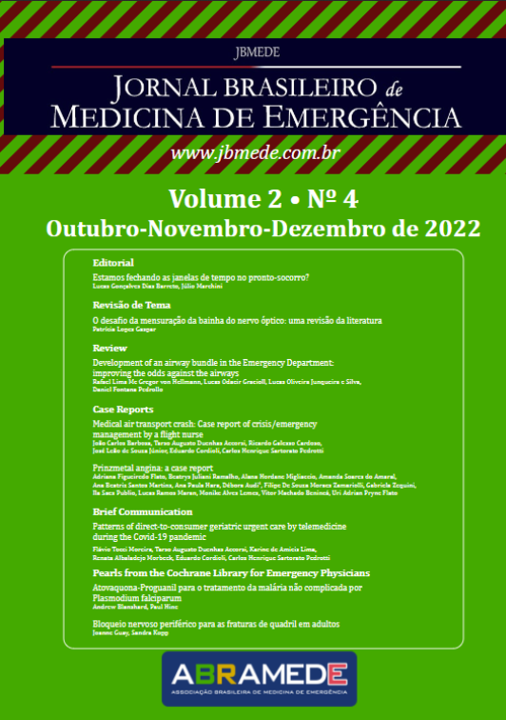Medical air transport crash: Case report of crisis/ emergency management by a flight nurse
Main Article Content
Abstract
Though medical air transport is a fast-developing field, no specific regulations have been formulated regarding the training and skills required by the health professionals involved in aeromedical missions, especially emergency nurses. Despite the potential benefits observed in case- and simulation-based training, there is a lack of evidence suggesting that a complete team training in all emergency skills leads to improved prognosis in a critical situation. Regarding non-technical skills, the repeated simulations of crisis resource management skills (problem solving, situational awareness, resource utilization, communication, and leadership) for nurses are associated with better knowledge retention. However, there is little demonstration of their relevance in improving the patient’s prognosis in real care situations. This paper is a case report of a medical air transport crash during the outbound segment of the flight. The aircraft sustained serious damage, and many of the crew were injured. The flight nurse was responsible for providing care to the other crew members, managing decision-making in life-threatening situations, and sharing information with the professionals on board the aircraft as well as with the rescue team. This report aims to demonstrate the importance of flight nurses and other medical crew (such as flight physicians and physiotherapists) being proficient in aircraft emergency procedures and receiving effective crisis resource management training.
Article Details

This work is licensed under a Creative Commons Attribution 4.0 International License.
References
Loyd JW, Larsen T, Swanson D. Aeromedical transport, 2021.
Treasure Island (FL): StatPearls Publishing; 2021 [cited 2022 Dez.
. Available from: https://www.ncbi.nlm.nih.gov/books/NBK518986/
Steenhoff TC, Siddiqui DI, Zohn SF. EMS air medical transport,
Treasure Island (FL): StatPearls Publishing; 2021 [cited 2022
Dez. 9]. Available from: https://www.ncbi.nlm.nih.gov/books/
NBK482358/
Masterson S, Deasy C, Doyle M, Hennelly D, Knox S, Sorensen J.
What clinical crew competencies and qualifications are required for
helicopter emergency medical services? A review of the literature.
Scand J Trauma Resusc Emerg Med. 2020 Apr 16;28(1):28.
Scuissiato DR, Boffi LV, Rocha RR, Montezeli JH, Bordin MT, Peres
AM. Compreensão de enfermeiros de bordo sobre seu papel na
equipe multiprofissional de transporte aeromédico. Rev Bras
Enferm. 2012;65(4):614-20.
Fung L, Boet S, Bould MD, Qosa H, Perrier L, Tricco A, et al. Impact
of crisis resource management simulation-based training for
interprofessional and interdisciplinary teams: A systematic review.
J Interprof Care. 2015;29(5):433-44.
Lei C, Palm K. Crisis resource management training in medical
simulation, 2021. Treasure Island (FL): StatPearls Publishing; 2021
[cited 2022 Dez. 9]. Available from: https://www.ncbi.nlm.nih.gov/
books/NBK551708/
Carne B, Kennedy M, Gray T. Crisis resource management in
emergency medicine. Emerg Med Australas. 2012;24(1):7-13.
Fletcher JL. AANA Journal course: Update for nurse anesthetists-
-ERR WATCH: Anesthesia crisis resource management from the
nurse anesthetist’s perspective. AANA J. 1998;66(6):595-602.
James AH, Bennett CL. Effective nurse leadership in times of crisis.
Nurs Manag (Harrow). 2020;27(4):32-40.
Lucas A, Edwards M, Harder N, Gillman L. Teaching crisis resource
management skills to nurses using simulation. J Contin Educ Nurs.
;51(6):257-66.
Grover E, Porter JE, Morphet J. An exploration of emergency
nurses’ perceptions, attitudes and experience of teamwork in the
emergency department. Australas Emerg Nurs J. 2017;20(2):92-7.
Hagyard-Wiebe T. Should critical care nurses be ACLS-trained?
Dynamics. 2007;18(4):28-31.
Williams K. Advanced practitioners in emergency care: A literature
review. Emerg Nurse. 2017;13;25(4):36-41.
Hudspeth RS, Klein TA. Understanding nurse practitioner scope of
practice: Regulatory, practice, and employment perspectives now
and for the future. J Am Assoc Nurse Pract. 2019;31(8):468-73.
Furlong E, Smith R. Advanced nursing practice: Policy, education
and role development. J Clin Nurs. 2005;14(9):1059-66.
Tan TC, Zhou H, Kelly M. Nurse-physician communication - An
integrated review. J Clin Nurs. 2017;26(23-24):3974-89.
Brasil. Ministério da Saúde. Gabinete do Ministro. Comissão
Intergestores Tripartite. Portaria Nº 2.048, de 5 de novembro de
Brasília, DF: Ministério da Saúde; 2002 [citado 2022 Dez.
. Disponível em: https://bvsms.saude.gov.br/bvs/saudelegis/
gm/2002/prt2048_05_11_2002.html
Agência Nacional de Aviação Civil (Anac). IS 00-010A: Treinamento
de gerenciamento de recursos de equipes (Corporate Resource
Management - CRM). Brasília, DF: Anac; 2020 [citado 2022 Dez.
. Disponível em: https://www.anac.gov.br/assuntos/legislacao/
legislacao-1/iac-e-is/is/is-00-010a
Mains R. Air medical resource management: our last line of
defense. Air Med J. 2015;34(2):78-81.
Braithwaite I, Steele AM. “Flight Nurses,” or “Nurses Who Fly”? An
international perspective on the role of flight nurses. Air Med J.
;39(3):196-202.
McCormick MM. The National Transportation Safety Board and the
investigation of civil aviation and transportation accidents. Am J
Forensic Med Pathol. 1980;1(3):239-43.

